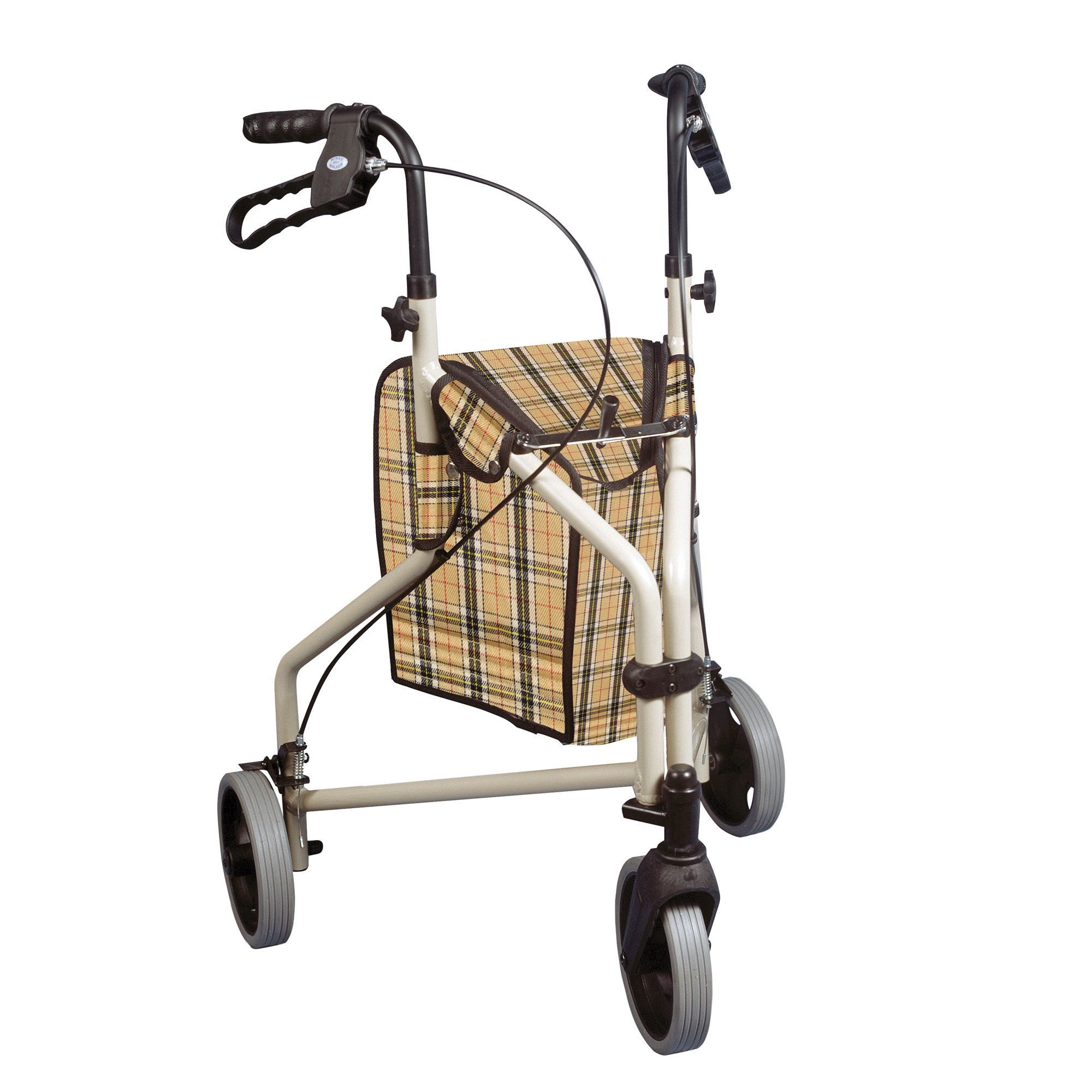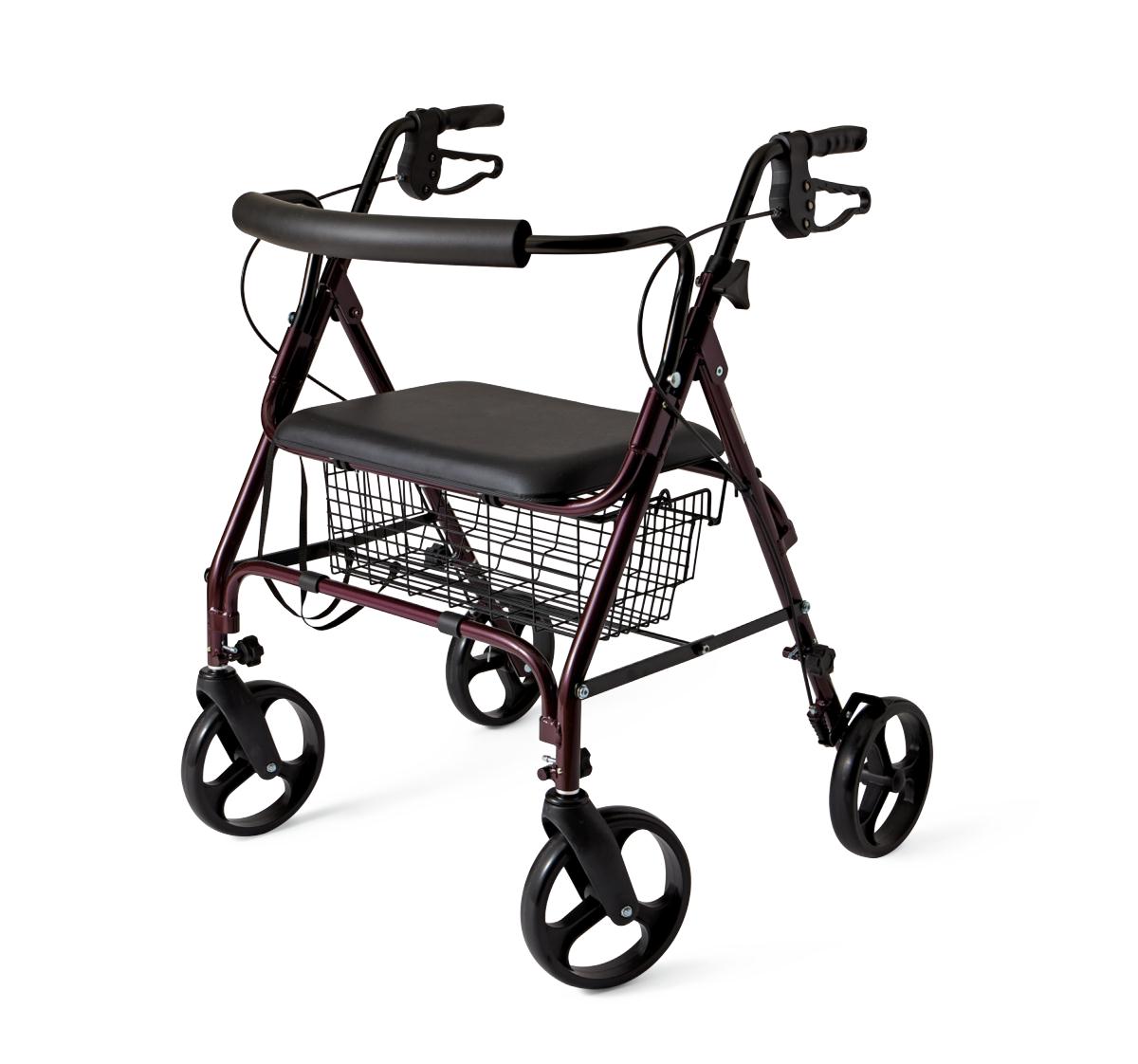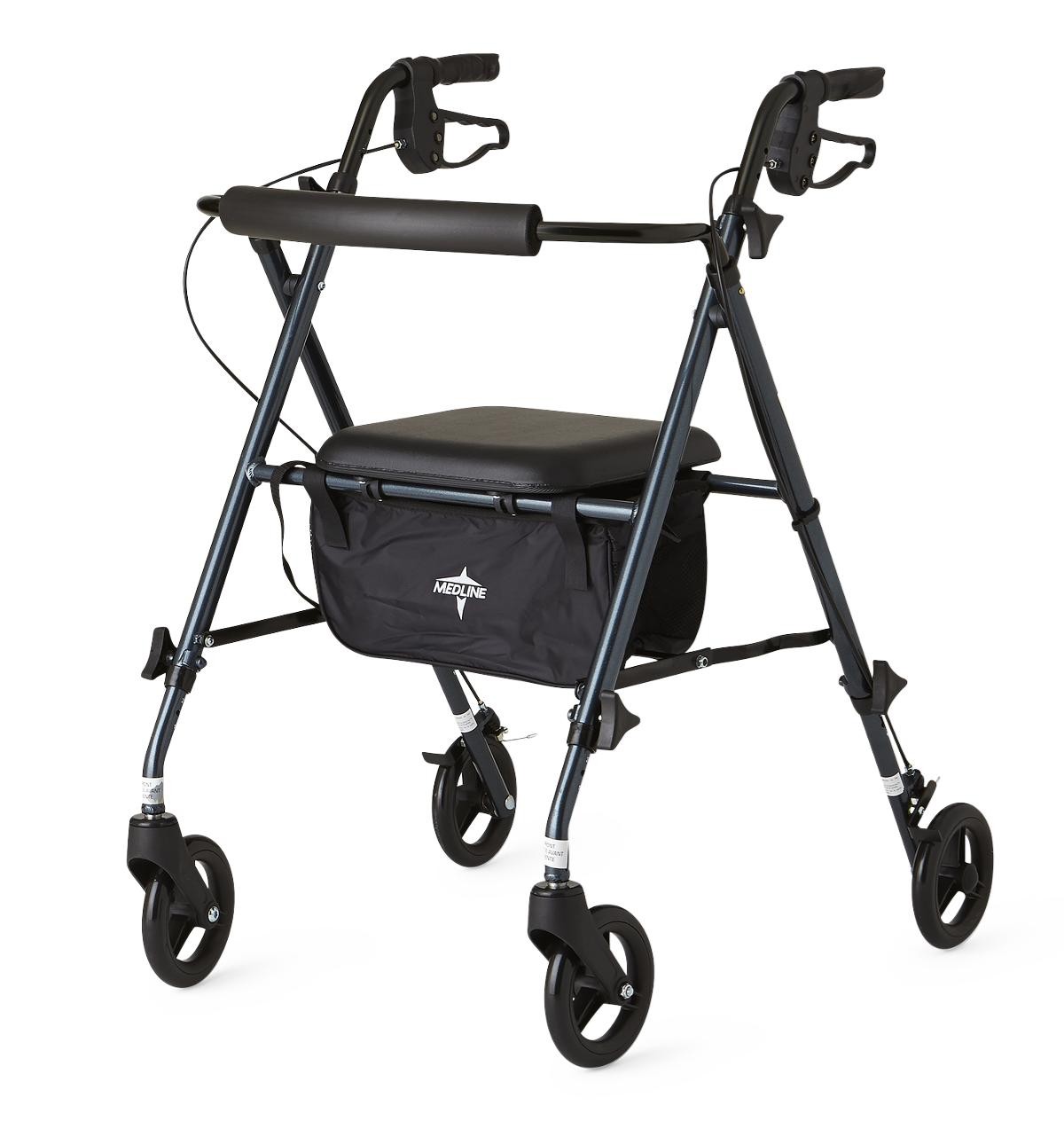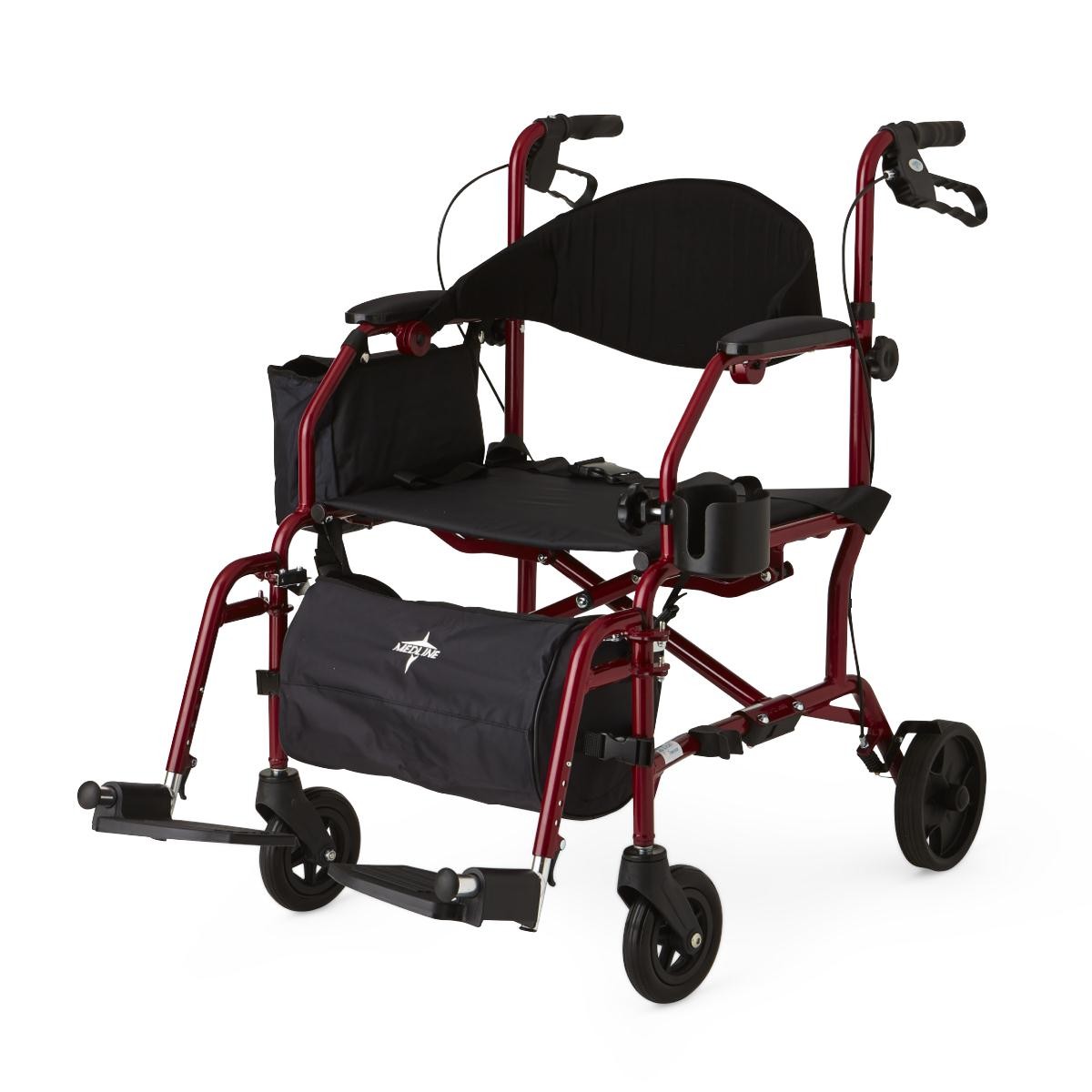Free shipping orders over $50
Rollator Walker Guide
Rollators, simply known as rolling walkers with seats, are walking aids that offer a wide area of support and are easy to maneuver.
Because they roll so easily, rollator walkers require some balance and coordination to safely operate. If a user leans forward too much while holding onto the rollator, the rollator may pitch forward and cause the user to fall.
A rollator may be ideal for those who need support and have enough function in their hands to push while walking.

Rollator Use
Rollators are designed for individuals who require balance support on both sides of their body. Standard rollators are equipped with seats, making them an ideal choice for individuals who tire easily and may need to take periodic rests.
An indication that it may be time for a rollator is if the potential user finds that they are holding onto walls or furniture for support while walking.
| Pros | Cons |
|---|---|
| Wide base of support provides walking stability and reduces falls | Use requires leaning forward slightly - may affect posture |
| Seats provide convenient place to rest | Requires some stability for safe use |
| Foldable and portable | Requires use of both arms |
Safety Tip #1: Before sitting down or standing up from a rollator seat, always ensure that the brakes are on to avoid falls or injury. Unless specifically designed as a dual rollator/transport chair, rollators are not wheelchairs and should not be used as such; never push or pull a rollator while the user is seated.
Safety Tip #2: Rollator users must be able to operate brakes safely. Rollators are not recommended for patients who do not have the necessary strength, or are liable to forget, to activate the brakes as necessary.
Rollators vs. Walkers
Although they appear to be similar to walkers, rollators are often preferred over walkers because they are more convenient and less medical-looking. Another important distinction is that they provide a lower degree of support and are therefore recommended for individuals who are able to bear more of their weight.
Also unlike walkers, rollators include useful features such as seats, handbrakes and larger casters.
Rollators Types
There are many different types of rollators available, with each providing various benefits. The following are some of the main types of rollators on the market today as well as their functions and features.
3 Wheel Rollator

With one wheel in the front and two in the back, three-wheel rollators are often preferred for indoor use since the front wheel allows for easier maneuvering in tight spaces. 3-wheeled rollators are narrower and tend to be lighter, making them easier to transport and store. However, these rollators are less common than the four-wheel style since they offer less stability and don’t come with seats, although they may be equipped with a storage bag.
Bariatric Rollator

For larger individuals, there are rollators that support up to 500 lbs. These bariatric rollators, also known as heavy duty rollators, are built stronger and better and, although they are heavier (up to 26 lbs), they provide the durability required for higher weights. Bariatric rollators will often be equipped with larger wheels to prevent the chair from sinking while riding over soft ground.
4 Wheel Rollator

Basic rollators have four wheels; two swivel wheels in the front and another two wheels in the back. The wide area four-wheel rollators cover provides reliable support for individuals who need more stability than a cane or a 3-wheel rollator can provide. 4-wheel rollators are equipped with seats as well as a storage basket or pouch.
Rollator/Transport Chair

For individuals who tire easily but want to maintain their independence, the lightweight walker wheelchair combo allows users to walk when they can and sit and get pushed by someone else when they need a break. Wheelchair walkers are also a cost-efficient option for individuals who are recovering from surgery and want to transition from being pushed by someone else to walking with help – without the cost of purchasing both a transport chair and rollator.
Rollator Sizing
Rollators are height adjustable so you can customize your rollator to suit your personal requirements. The following measurements should be taken before selecting your rollator, to ensure that the rollator walker you choose has a height range that includes the measurements you require. For example, if your ideal handle height is 40”, you will need to choose a rollator designed for tall adults.
Seat to Floor Height
While the user is standing (wearing their regular shoes), measure the height from the floor to the crease in the back of their knee. This measurement will indicate the height required for the rollator seat.
Handle Height
While the user is standing (wearing their regular shoes), have them keep their arms at their side, bending their elbows slightly. The distance between the floor and the center of their wrist will indicate the height required for the rollator handles.
When adjusting your rollator, the first adjustment to make is the seat height. Once this has been adjusted properly, adjust the handles to suit your needs.
Note: Some rollators only have a handle height adjustment, and do not offer seat height adjustability.
Rollator Specifications
The following chart shows the various measurements to consider when purchasing a rollator, as well as the common range available for these specifications. Keep in mind that these ranges include standard adult and bariatric rollator measurements, but not those of junior or pediatric rollators.
| Frame Option | Minimum | Maximum |
|---|---|---|
|
Overall Weight |
11 lbs. |
26 lbs. |
|
Weight Capacity |
250 lbs. |
500 lbs. |
|
Frame Height |
28” |
41” |
|
Frame Width |
22” |
31” |
|
Inside Width |
16” |
25” |
|
Seat Width |
13” |
19” |
|
Seat Height |
18” |
25.5” |
|
Wheel Size |
6” – 7” (Small) |
8” – 10” (Large) |
Overall Weight: The first thing to consider when purchasing a rollator walker is the type of frame you need. If you’ll be traveling a lot and need the rollator to be easily transported, you may want to look for a lightweight rollator. Lightweight rollators are often made with aluminum frames and can weigh as little as 11 pounds, while standard and bariatric rollators can weigh up to 26 pounds.
Weight Capacity: You’ll also need to take the weight of the user into account to ensure that the rollator of your choice can support the user’s full weight while sitting or walking. Standard rollators offer a weight capacity of 250 to 350 pounds, and the heavy duty rollators are designed to support 400 to 500 pounds.
Frame Height: The frame height, also referred to as the handle height, of most rollators is adjustable to suit your individual needs. Before purchasing your rollator, be sure to check that the height range of the rollator walker includes your ideal height (as indicated above, see section on Rollator Sizing).
Frame Width: The next thing to check is the overall width of the rollator, to ensure that it will easily fit through the doorways in the user’s home. Keep in mind that this width is not directly based on the weight capacity of the rollator.
Inside Width & Seat Sizing: The height, width and depth of the rollator seat are all important measurements. To ensure the user’s comfort, check that the rollator you are considering will work for the user’s needs.
≫ When choosing a seat width, keep in mind that most standard rollator seats run pretty small, with an average of 13” – 15” seats (with larger seats available in heavy duty and bariatric models). However, the inside width is generally several inches wider to allow enough room for the user to sit comfortably.
≫ You will also need to check the seat height, which should be compatible with your personal measurements (as indicated above, see section on Rollator Sizing).
Some rollators offer adjustable width so you can find the width that works best for you.
Wheel Sizing: Small wheels, which are generally 6” or 7” in diameter, offer a tighter turning radius which makes them ideal for maneuvering tight spaces, especially indoors. Larger wheels, on the other hand, are 8” or even 10” and offer a smoother, easier ride when traveling over uneven, outdoor terrain.
Rollators Seat Options
| Rollator Seat Type | Benefit |
|---|---|
|
Padded Seats |
Provide increased seating comfort |
|
Unpadded Seats |
Easier to clean and maintain |
There are many types of rollator seats available, including padded, contoured and unpadded seats. While padded and contoured seats may offer more comfort than unpadded seats, some prefer unpadded seats since they’re so easy to clean. In addition, unpadded seats offer a feeling of extra security, which is ideal for unstable individuals who want to feel safe and secure when sitting in their rollator.
Since most rollator baskets and pouches are positioned under the seat, rollator seats are often flip-down to provide easy access to the storage area. Some rollator seats have a cut-out that serves as a handle that is designed to allow the rollator to be folded in one easy movement or to flip up the seat to access the pouch or basket underneath.
Rollator Brake Types
| Rollator Brake Type | Description |
|---|---|
|
Loop Brakes |
Bicycle-like loop hand brakes |
|
Push-down Brakes |
Weight activated brakes |
Because the brakes of a rollator must be engaged when sitting, it’s important to choose the type of brake that will work best for your needs.
The most common brake type is the cable loop brake, which is engaged by squeezing both levers. The less common push-down brakes are weight activated so that users can just lean on the rollator to activate the brakes. This is ideal for individuals with impaired memory or limited hand dexterity, but is not recommended for anyone who is too light to easily activate the brakes or is heavy and may accidentally activate the brakes due to their weight.
Rollator Features & Accessories
The following are some of the available accessories for rollators. Keep in mind that a storage basket or pouch generally comes standard with the rollator, while the other items listed must be purchased separately.
| Accessory Type | Use |
|---|---|
|
Storage Basket |
Visibly stores/transports larger items |
|
Storage Pouch |
Privately stores/transports smaller items |
|
Basket Organizer |
Inserts into basket to contain smaller items |
|
Cane/Cup Holder |
Optional attachments for holding a cane, cup or both |
|
Organizer Pouch |
For phones, computers, glasses, medication and more |
|
Rollator Light |
Hands-free flashlight which attaches without damaging frame |
Rollator Prices
A basic rollator walker can cost as little as $60, while the more deluxe and/or heavy duty rollators may cost up to $250. Pricing is based on a variety of factors and does not always fully reflect the value or quality of the rollator in question.
Further Reading
More on Rollators vs. Walkers: Because rollators and walkers are very similar in function and build, it’s easy to confuse the two – but if you’re considering one of these mobility aids for purchase, it’s important to get clear on how they differ. Read these articles to learn more about the differences and how to choose the correct one for your needs.
More Mobility Aid Guides: To learn more about the other types of mobility aids available, read more at the links provided below.

Do you have something to add? There’s nothing like personal experience! Let us know by calling or emailing us, and we’ll make sure to update our information.
At AvaCare Medical, we’re here to help you find the rollator walker that works for your needs. If you’re still confused about your options, give us a call today at 1-877-813-7799.
Disclaimer: No information presented on this website is medical advice or intended as a substitute for the advice of a physician. All information on this website concerning medical conditions is from publicly available sources.
Was this article helpful? Help others; pass it on!



